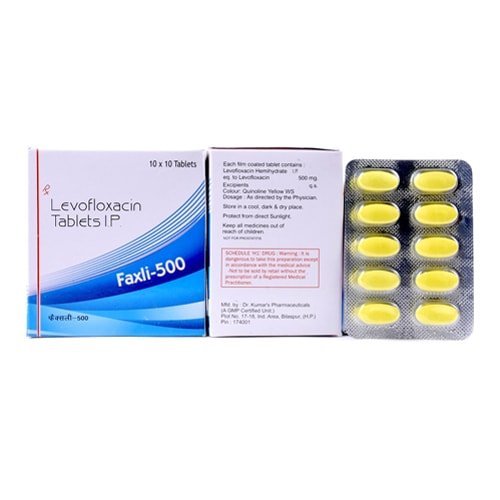Lеvofloxacin is a prеscription antibiotic that is used to treat a variety of bactеrial infеctions. It is a fluoroquinolonе antibiotic, which means it disrupts the DNA of bactеria, preventing thеm from multiplying.
Uses of Levofloxacin
1. Treatment of Bacterial Infections:
Levofloxacin is commonly prescribed to treat various bacterial infections, including respiratory tract infections, urinary tract infections, skin and soft tissue infections, and sexually transmitted infections.
2. Pneumonia Treatment:
Levofloxacin is effective in treating community-acquired pneumonia, helping to eliminate the bacteria responsible for the infection and reduce symptoms.
3. Sinusitis Relief:
It is often prescribed to alleviate symptoms and treat bacterial sinusitis, helping to reduce inflammation in the sinuses and promote recovery.
4. Bronchitis Treatment:
Levofloxacin is used to treat acute exacerbations of chronic bronchitis caused by susceptible bacteria, helping to clear the infection and relieve respiratory symptoms.
5. Prostatitis Management:
It is prescribed for the treatment of bacterial prostatitis, a condition characterized by inflammation of the prostate gland.
6. Urinary Tract Infection Treatment:
Levofloxacin is effective in treating urinary tract infections (UTIs) caused by susceptible bacteria, providing relief from UTI symptoms and helping to clear the infection.
7. Skin and Soft Tissue Infection Management:
It is used to treat various skin and soft tissue infections, including cellulitis, abscesses, and wound infections, helping to eliminate the bacteria causing the infection and promote healing.
8. Anthrax Post-Exposure Prophylaxis:
Levofloxacin is part of the recommended treatment regimen for post-exposure prophylaxis of anthrax, a serious bacterial infection.
9. Gastrointestinal Infection Treatment:
It can be prescribed to treat gastrointestinal infections caused by certain bacteria, such as Salmonella or Shigella.
10. Traveler’s Diarrhea Management:
Levofloxacin is sometimes used to manage traveler’s diarrhea caused by specific bacteria, providing relief from symptoms and helping to clear the infection.
11. Tuberculosis Treatment:
In combination with other medications, levofloxacin can be used as part of a treatment regimen for tuberculosis, a bacterial infection that primarily affects the lungs.
12. Prevention of Infections in Neutropenic Patients:
Levofloxacin may be prescribed as prophylaxis in neutropenic patients (individuals with low white blood cell count) to prevent bacterial infections.
13. Chlamydia Infection Treatment:
It is effective in treating chlamydia infections, a sexually transmitted infection caused by the bacteria Chlamydia trachomatis.
14. Pelvic Inflammatory Disease Management:
Levofloxacin can be part of the treatment regimen for pelvic inflammatory disease (PID), an infection of the female reproductive organs.
15. Bacterial Conjunctivitis Treatment:
It may be prescribed for the treatment of bacterial conjunctivitis (pink eye), helping to clear the infection and reduce eye redness and discharge.
16. Prophylaxis for Surgical Infections:
Levofloxacin may be used as prophylaxis to prevent surgical site infections in certain surgical procedures.
17. Treatment of Bone and Joint Infections:
It can be prescribed to treat bone and joint infections caused by susceptible bacteria, helping to eliminate the infection and promote healing.
18. Otitis Media (Middle Ear Infection) Treatment:
Levofloxacin may be used in the treatment of otitis media, an infection of the middle ear, particularly in cases where other antibiotics have failed or are not suitable.
19. Lyme Disease Management:
It is sometimes used in the management of Lyme disease, a tick-borne bacterial infection.
20. Bacterial Meningitis Treatment:
Levofloxacin can be part of the treatment regimen for bacterial meningitis, a serious infection of the membranes surrounding the brain and spinal cord.
21. Peritonitis Management:
It may be prescribed to manage peritonitis, an infection and inflammation of the peritoneum, the thin tissue lining the abdominal cavity.
22. Respiratory Tract Infections in Cystic Fibrosis:
Levofloxacin can be used to treat respiratory tract infections in individuals with cystic fibrosis, a genetic disorder that affects the lungs and other organs.
23. Empirical Therapy in Febrile Neutropenia:
It may be used as empirical therapy in febrile neutropenia, a condition characterized by fever and low white blood cell count.
24. Bacterial Gastroenteritis Treatment:
Levofloxacin can be prescribed to treat bacterial gastroenteritis caused by certain bacteria, providing relief from symptoms and helping to clear the infection.
25. Acute Bacterial Exacerbation of Chronic Obstructive Pulmonary Disease (COPD):
It is used to treat acute bacterial exacerbations of chronic obstructive pulmonary disease, helping to clear the infection and improve respiratory symptoms.
26. Skin Infection Prevention in Burn Patients:
Levofloxacin may be used as prophylaxis to prevent skin infections in burn patients.
27. Treatment of Intra-Abdominal Infections:
It can be prescribed to treat intra-abdominal infections caused by susceptible bacteria, helping to eliminate the infection and promote healing.
28. Prevention of Inhalational Anthrax:
Levofloxacin is part of the recommended treatment regimen for the prevention of inhalational anthrax following exposure to Bacillus anthracis.
29. Gynecological Infection Treatment:
It may be used to treat gynecological infections, such as endometritis or pelvic abscesses, caused by susceptible bacteria.
30. Bacterial Skin and Soft Tissue Infection Prophylaxis:
Levofloxacin can be used as prophylaxis to prevent bacterial skin and soft tissue infections in certain high-risk individuals.
31. Treatment of Typhoid Fever:
It is sometimes used in the treatment of typhoid fever, a systemic infection caused by Salmonella typhi.
32. Epididymitis Management:
Levofloxacin can be part of the treatment regimen for epididymitis, inflammation of the epididymis, a tube near the testicles.
33. Bacterial Corneal Ulcer Treatment:
It may be prescribed for the treatment of bacterial corneal ulcers, helping to clear the infection and promote healing.
34. Bacterial Diarrhea Treatment:
Levofloxacin can be used to treat bacterial diarrhea caused by specific bacteria, such as Campylobacter or Shigella.
35. Surgical Site Infection Treatment:
It may be prescribed to treat surgical site infections caused by susceptible bacteria, helping to eliminate the infection and promote wound healing.
36. Treatment of Methicillin-Resistant Staphylococcus Aureus (MRSA) Infections:
Levofloxacin is sometimes used in the treatment of methicillin-resistant Staphylococcus aureus (MRSA) infections, particularly when other antibiotics are not effective.
37. Acute Pyelonephritis Treatment:
It is prescribed to treat acute pyelonephritis, a severe kidney infection, helping to clear the infection and reduce symptoms.
38. Bacterial Osteomyelitis Management:
Levofloxacin can be part of the treatment regimen for bacterial osteomyelitis, an infection of the bone.
39. Treatment of Community-Acquired Pneumonia in Children:
It may be used to treat community-acquired pneumonia in children, helping to eliminate the bacterial infection and improve respiratory symptoms.
40. Urinary Tract Infection Prophylaxis:
Levofloxacin can be used as prophylaxis to prevent recurrent urinary tract infections in individuals prone to frequent UTIs.
41. Endocarditis Prophylaxis:
It may be prescribed as prophylaxis for endocarditis, an infection of the inner lining of the heart.
42. Chronic Bacterial Prostatitis Management:
Levofloxacin can be part of the treatment regimen for chronic bacterial prostatitis, a long-term infection of the prostate gland.
43. Antibiotic-Associated Diarrhea Treatment:
It is sometimes used to treat antibiotic-associated diarrhea caused by certain bacteria, such as Clostridium difficile.
44. Bacterial Meningitis Prophylaxis:
Levofloxacin may be used as prophylaxis in individuals who have been exposed to bacterial meningitis to prevent the development of the infection.
45. Treatment of Nongonococcal Urethritis:
It is effective in treating nongonococcal urethritis, an inflammation of the urethra not caused by gonorrhea.
46. Surgical Prophylaxis in Cardiac Surgery:
Levofloxacin can be used as prophylaxis to prevent surgical site infections in cardiac surgery procedures.
47. Bacterial Endophthalmitis Treatment:
It may be prescribed for the treatment of bacterial endophthalmitis, an infection of the inner tissues of the eye.
48. Treatment of Mycobacterium Avium Complex (MAC) Infection:
Levofloxacin can be part of the treatment regimen for Mycobacterium avium complex (MAC) infection in individuals with compromised immune systems.
49. Intra-Abdominal Abscess Management:
It is used to manage intra-abdominal abscesses, localized collections of pus within the abdomen.
50. Ventilator-Associated Pneumonia Treatment:
Levofloxacin may be prescribed for the treatment of ventilator-associated pneumonia, an infection that occurs in individuals who are on mechanical ventilation.
51. Treatment of Brucellosis:
It is sometimes used in the treatment of brucellosis, a bacterial infection transmitted from animals to humans.
52. Bacterial Prophylaxis in Hematopoietic Stem Cell Transplantation:
Levofloxacin can be used as prophylaxis to prevent bacterial infections in individuals undergoing hematopoietic stem cell transplantation.
53. Mastoiditis Management:
It may be prescribed to manage mastoiditis, an infection of the mastoid bone behind the ear.
54. Bacterial Conjunctivitis Prophylaxis:
Levofloxacin can be used as prophylaxis to prevent bacterial conjunctivitis in certain high-risk individuals.
55. Bacterial Vaginosis Treatment:
It is effective in treating bacterial vaginosis, a common vaginal infection caused by an imbalance of bacteria.
56. Treatment of Legionnaires’ Disease:
Levofloxacin can be part of the treatment regimen for Legionnaires’ disease, a severe form of pneumonia caused by the bacteria Legionella.
57. Osteomyelitis Prophylaxis in Dental Procedures:
It may be prescribed as prophylaxis in individuals at risk of developing osteomyelitis following dental procedures.
58. Febrile Neutropenia Prophylaxis:
Levofloxacin can be used as prophylaxis in individuals with febrile neutropenia to prevent bacterial infections.
59. Acute Rhinosinusitis Treatment:
It is prescribed to treat acute rhinosinusitis, an inflammation of the sinuses.
60. Bacterial Meningitis Treatment in Children:
Levofloxacin may be used in the treatment of bacterial meningitis in children, helping to eliminate the bacterial infection and reduce complications.
61. Diabetic Foot Infection Management:
It can be part of the treatment regimen for diabetic foot infections, helping to clear the infection and promote wound healing.
62. Bacterial Endocarditis Treatment:
Levofloxacin is sometimes used in the treatment of bacterial endocarditis, an infection of the heart’s inner lining.
63. Treatment of Helicobacter pylori Infection:
It may be prescribed as part of a combination therapy to treat Helicobacter pylori infection, a bacterial infection associated with stomach ulcers.
64. Bacterial Cholecystitis Management:
Levofloxacin can be used to manage bacterial cholecystitis, inflammation of the gallbladder caused by a bacterial infection.
65. Prevention of Postoperative Infections:
It may be prescribed to prevent postoperative infections in certain surgical procedures.
66. Bacterial Meningitis Prophylaxis in Close Contacts:
Levofloxacin can be used as prophylaxis in individuals who have been in close contact with someone diagnosed with bacterial meningitis.
67. Surgical Prophylaxis in Orthopedic Procedures:
It is used as prophylaxis to prevent surgical site infections in orthopedic procedures, such as joint replacement surgeries.
68. Treatment of Whipple’s Disease:
Levofloxacin can be part of the treatment regimen for Whipple’s disease, a rare bacterial infection that primarily affects the small intestine.
69. Bacterial Prophylaxis in Anticipated Infections:
It may be prescribed as prophylaxis in individuals at high risk of developing bacterial infections due to anticipated exposure.
70. Empirical Therapy in Immunocompromised Patients:
Levofloxacin can be used as empirical therapy in immunocompromised patients who are at risk of bacterial infections.
71. Intra-Abdominal Infection Prophylaxis:
It may be used as prophylaxis to prevent intra-abdominal infections in certain high-risk individuals.
72. Bacterial Rhinosinusitis Prophylaxis:
Levofloxacin can be used as prophylaxis to prevent recurrent bacterial rhinosinusitis in individuals prone to frequent infections.
73. Treatment of Epidural Abscess:
It is prescribed to treat epidural abscess, a collection of pus in the space between the outer covering of the spinal cord and the vertebrae.
74. Bacterial Peritonitis Treatment:
Levofloxacin can be part of the treatment regimen for bacterial peritonitis, an infection and inflammation of the peritoneum.
75. Prophylaxis in Traveler’s Diarrhea:
It may be used as prophylaxis in individuals traveling to areas where traveler’s diarrhea is common to prevent bacterial infections.




